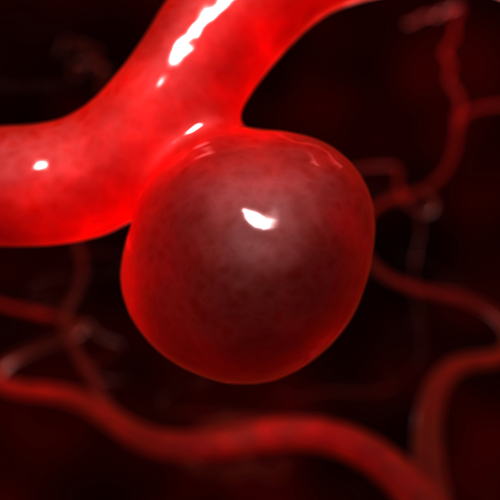Aneurysm
Definition of Aneurysm
The word aneurysm is derived from a Greek word aneurysm which means “dilation.” It is a medical condition in which there is localized balloon-like bulge in the wall of a blood vessel. In simpler words, it is an abnormal dilatation of a blood vessel that results in abnormal blood flow through it.
Aneurysms are classified into three groups:
-
According to type of aneurysm
An aneurysm may either be a true aneurysm or a false aneurysm. In true aneurysm all the layers of the vessel wall (intima, media and tunica) are involved and include atherosclerotic, syphilitic and congenital aneurysms.
False (pseudo) aneurysms may be caused by trauma to the vessel that punctures it. In this case the blood leaks out of the vessel and stays confined to it by the surrounding tissue. This injury may result from a knife, bullet or during injection into the artery.
-
According to morphology (physical appearance)
Aneurysms may differ in their macroscopic size and shape. They may be either saccular or fusiform.
Saccular aneurysms are spherical. They are often filled by a thrombus and involve only a portion of the vessel.
Fusiform aneurysms are variable in size and diameter. They usually involve a larger portion of the vessel wall.
-
According to location
Aneurysms are found in different location in different situations. They may be found in the arteries or veins, heart, aorta, brain, legs, kidneys, etc.
Cause of Aneurysm
Aneurysms develop when the blood vessels get weak. There are a number of acquired and inherited cause of aneurysms. The infective causes are:
-
Advanced syphilis
-
Tuberculosis
-
Brain infections
Some of the inherited ones are:
-
Polycystic kidney disease causing berry aneurysms of the arteries of circle of Willis (blood vessels at the base of the brain)
-
Familial thoracic aortic aneurysms
- Cirsoid aneurysms which arise due to congenital arteriovenous malformations
Signs and Symptoms of Aneurysm
The clinical presentation of aneurysms vary and depend on the location of aneurysm. In some instances there may be a life threatening complication like hypovolemic shock and in the others it may be incidentally found on X-ray.
Cerebral aneurysm
These symptoms arise when the aneurysm pushes or compresses an adjacent area of the brain.
-
Fatigue
-
Imbalance
-
Double vision
-
Difficulty in speech
-
Headache
-
Pain in the neck
-
Pain in the region of eyes (above or behind)
Abdominal aneurysm
Aneurysm in the region of the abdomen can cause:
-
Pain in the central region of back
-
Edema and deep venous thrombosis
-
Vomiting
-
Ischemia of the lower limb
Kidney aneurysm
These may cause:
-
Tenderness in flank
-
High blood pressure
-
Hematuria (blood in urine)
-
Hypovolemic shock
Risk factors for Aneurysm
Risk factors for an aneurysm include:
- Diabetes
- Obesity
- Hypertension
- Tobacco use
- Alcoholism
- High cholesterol
- Copper deficiency
- Increasing age
- Congenital, or inherited, weakness in artery walls
Diagnosis of Aneurysm
Diagnosis of an aneurysm is usually made through Computed Tomography (CT) scan. In some cases, however, lumbar puncture is also done. The need for this arises when there is suspicion of a ruptured aneurysm in the brain.
Prevention from Aneurysm
Steps you can take to avoid other risk factors include:
- Quit smoking
- Follow a healthy diet. Eat a low-fat, low-cholesterol diet to reduce plaque (fatty deposits) in the arteries
- Control high blood pressure
- Keep cholesterol at healthy level
- Exercise regularly
Treatment of Aneurysm
The treatment for aneurysm is mostly done through a surgical procedure in which the area of the aneurysm is targeted and either clipping or endovascular coiling is done. Sometimes bypassing is also done.

